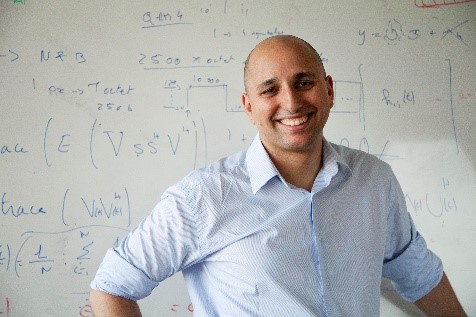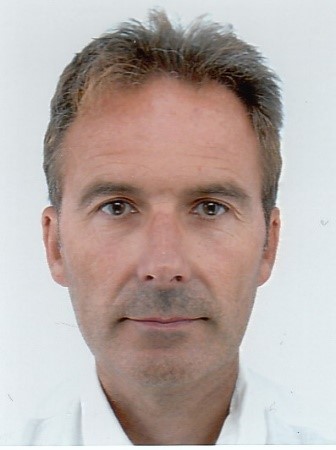 |
Prof. Mérouane Debbah, Huawei France Research Center, France
Abstract: 5G and the Wireless Road Ahead.
The standardization for 5G wireless systems is maturing and researchers around the world have already started to look at beyond the 5G systems. Although the next G gossip is at a premature stage, this talk aims to provide an overview of the vision, challenges and key enabling technologies envisioned by the wireless community. The talk will mostly focus on the fundamental technologies and will discuss potential research directions to meet the requirements of next generation wireless systems. |
|
Biography:
Mérouane Debbah (S’01–M’04–SM’08–F’15) received the M.Sc. and Ph.D. degrees from the Ecole Normale Supérieure Paris-Saclay, France. He was with Motorola Labs, Saclay, France, from 1999 to 2002, and also with the Vienna Research Center for Telecommunications, Vienna, Austria, until 2003. From 2003 to 2007, he was an Assistant Professor with the Mobile Communications Department, Institut Eurecom, Sophia Antipolis, France. In 2007, he was appointed Full Professor at CentraleSupelec, Gif-sur-Yvette, France. From 2007 to 2014, he was the Director of the Alcatel-Lucent Chair on Flexible Radio. Since 2014, he has been a Vice-President of the Huawei France Research Center and the Director of the Mathematical and Algorithmic Sciences Lab. He has managed 8 EU projects and more than 24 national and international projects. His research interests lie in fundamental mathematics, algorithms, statistics, information, and communication sciences research. He is an IEEE Fellow, a WWRF Fellow, and a Membre émérite SEE. He was a recipient of the ERC Grant MORE (Advanced Mathematical Tools for Complex Network Engineering) from 2012 to 2017. He was a recipient of the Mario Boella Award in 2005, the IEEE Glavieux Prize Award in 2011, the Qualcomm Innovation Prize Award in 2012 and the 2019 IEEE Radio Communications Committee Technical Recognition Award. He received 20 best paper awards, among which the 2007 IEEE GLOBECOM Best Paper Award, the Wi-Opt 2009 Best Paper Award, the 2010 Newcom++ Best Paper Award, the WUN CogCom Best Paper 2012 and 2013 Award, the 2014 WCNC Best Paper Award, the 2015 ICC Best Paper Award, the 2015 IEEE Communications Society Leonard G. Abraham Prize, the 2015 IEEE Communications Society Fred W. Ellersick Prize, the 2016 IEEE Communications Society Best Tutorial Paper Award, the 2016 European Wireless Best Paper Award, the 2017 Eurasip Best Paper Award, the 2018 IEEE Marconi Prize Paper Award, the 2019 IEEE Communications Society Young Author Best Paper Award and the Valuetools 2007, Valuetools 2008, CrownCom 2009, Valuetools 2012, SAM 2014, and 2017 IEEE Sweden VT-COM-IT Joint Chapter best student paper awards. He is an Associate Editor-in-Chief of the journal Random Matrix: Theory and Applications. He was an Associate Area Editor and Senior Area Editor of the IEEE TRANSACTIONS ON SIGNAL PROCESSING from 2011 to 2013 and from 2013 to 2014, respectively.
|
|
 |
Prof. Pascal Lorenz, University of Haute-Alsace, France, France.
Abstract: Advanced architectures of Next Generation Networks
Internet Quality of Service (QoS) mechanisms are expected to enable wide spread use of real time services. New standards and new communication architectures allowing guaranteed QoS services are now developed. We will cover the issues of QoS provisioning in heterogeneous networks, Internet access over 5G networks and discusses most emerging technologies in the area of networks and telecommunications such as IoT, SDN, Edge Computing and MEC networking. We will also present routing, security, baseline architectures of the inter-networking protocols and end-to-end traffic management issues.
. |
|
Biography:
Pascal Lorenz (lorenz@ieee.org) received his M.Sc. (1990) and Ph.D. (1994) from the University of Nancy, France. Between 1990 and 1995 he was a research engineer at WorldFIP Europe and at Alcatel-Alsthom. He is a professor at the University of Haute-Alsace, France, since 1995. His research interests include QoS, wireless networks and high-speed networks. He is the author/co-author of 3 books, 3 patents and 200 international publications in refereed journals and conferences. He was Technical Editor of the IEEE Communications Magazine Editorial Board (2000-2006), IEEE Networks Magazine since 2015, IEEE Transactions on Vehicular Technology since 2017, Chair of IEEE ComSoc France (2014-2018), Financial chair of IEEE France (2017-2019), Chair of Vertical Issues in Communication Systems Technical Committee Cluster (2008-2009), Chair of the Communications Systems Integration and Modeling Technical Committee (2003-2009), Chair of the Communications Software Technical Committee (2008-2010) and Chair of the Technical Committee on Information Infrastructure and Networking (2016-2017). He has served as Co-Program Chair of IEEE WCNC'2012 and ICC'2004, Executive Vice-Chair of ICC'2017, TPC Vice Chair of Globecom'2018, Panel sessions co-chair for Globecom'16, tutorial chair of VTC'2013 Spring and WCNC'2010, track chair of PIMRC'2012 and WCNC'2014, symposium Co-Chair at Globecom 2007-2011, Globecom'2019, ICC 2008-2010, ICC'2014 and '2016. He has served as Co-Guest Editor for special issues of IEEE Communications Magazine, Networks Magazine, Wireless Communications Magazine, Telecommunications Systems and LNCS. He is associate Editor for International Journal of Communication Systems (IJCS-Wiley), Journal on Security and Communication Networks (SCN-Wiley) and International Journal of Business Data Communications and Networking, Journal of Network and Computer Applications (JNCA-Elsevier). He is senior member of the IEEE, IARIA fellow and member of many international program committees. He has organized many conferences, chaired several technical sessions and gave tutorials at major international conferences. He was IEEE ComSoc Distinguished Lecturer Tour during 2013-2014.
|
|
 |
Prof. Nabil Abdennadher, University of Applied Sciences and Arts, Western Switzerland (HES-SO), Switzerland
Abstract: Towards a hybrid Edge-Cloud platform for Self-Adaptive Machine Learning based IoT applications.
Cloud computing traditionally serves IoT applications by providing storage for generated data, and CPU power to produce value for their businesses. However, the growth of IoT is affecting the way traditional cloud architectures work. The increased amount of data to be transferred is creating bottlenecks while increasing the latency. Furthermore, sending such a big amount of data to a cloud environment in very short periods of time is inefficient, apart from cumbersome and expensive. This implies that much of this data must be aggregated at the “end points” where data is collected. And here is where Edge computing comes in. Edge Computing is not devised as a competitor to cloud; it is envisioned as the perfect ally for a broad spectrum of applications for which traditional Cloud Computing is not sufficient. Combining the edge approach with IoT sensors and Cloud would add flexibility and choices for users. The talk will be organized in two steps. The first step will answer these questions: 1. What problems does edge computing solve? 2. How can we take advantage of the edge computing? 3. How does edge computing and cloud computing work together? 4. How to balance the load between the edge and the cloud? 5. What are the current technologies for designing hybrid platforms (edge, cloud) for IoT applications? These technologies will be illustrated by demonstrations.
The second step will present a generic open-source platform for intelligent IoT applications based on a shareable backbone infrastructure composed of three layers: IoT objects, edge devices and cloud infrastructure. |
|
Biography:
Nabil Abdennadher received the Diploma in Engineering (Computer science) from Ecole Nationale des Sciences de l’Informatique (ENSI, Tunisia), and the Ph.D. degrees in Computer Science from University of Valenciennes (France) in 1988 and 1991, respectively. He was an assistant professor at the University of Tunis II from 1992 to 1998 and a research assistant at the Computer Science Department of the Swiss Federal Institute of Technology (EPFL) from 1999 to 2000. In 2001, he joined the Department of Computer Engineering at the University of Applied Sciences, Western Switzerland (HES-SO, hepia) as an assistant HES professor. In 2008, he became an associate HES professor and in 2017 he was promoted to full HES professor. Nabil Abdennadher is currently head of both the inIT Research Institute and the Large Scale Distributed Systems research group (lsds.hesge.ch). He is the representative of the Swiss Alliance for Data-Intensive Services in Swiss Romandie and member of the Editorial Board of the Journal of Reliable Intelligent Environments. His major research interests include high performance and distributed computing, Internet of Things and urban computing. Nabil Abdennadher participates in several research projects funded by Europe and several Swiss research foundations (InnoSuisse, swissuniversities, AAI Switch, CTI).
|
|
 |
Prof. Sanjay Ranka, University of Florida, USA
Abstract: Big data Computing and Machine Learning for Intelligent Transportation and Connected Vehicles.
We are developing machine learning algorithms and software to fuse real-time feeds from video cameras and traffic sensor data to generate real-time detection, classification, and space-time trajectories of individual vehicles and pedestrians. This information is then transmitted to a cloud-based system and then synthesized to create a real-time city-wide traffic palette. I will discuss our research on:
• Smart intersections: Space-time trajectories are used to understand and improve the safety and efficiency of the intersection. Using conflict points of the vehicle-pedestrian trajectories, we identify potential collisions, or “near-misses,” and how they are related to the state of the signal cycle (transition from green to yellow, from yellow to red, etc.) and the presence of other vehicles and pedestrians.
• Smart system: We are developing efficient signal re-timing for different corridors by time of day and day of the week to reflect the changes in network demand. We are also developing machine learning techniques for real-time detection of incidents and accidents on arterial networks.
• Smart interactions with connected and autonomous vehicles: We have developed signalized intersection control strategies and sensor fusion algorithms for jointly optimizing vehicle trajectories and signal control for a mixture of autonomous vehicles and traditional vehicles at every intersection.
|
|
Biography:
Sanjay Ranka is a Professor in the Department of Computer Information Science and Engineering at University of Florida. His current research interests are high performance and parallel computing with a focus on energy efficiency; and big data science with a focus on datamining/machine learning algorithms for spatiotemporal applications. His work is driven by applications in CFD, remote sensing, health care and transportation. He teaches courses on data science (three course curriculum), data mining and parallel computing. From 1999-2002, he was the Chief Technology Officer at Paramark (Sunnyvale, CA). At Paramark, he developed a real-time optimization service called PILOT for marketing campaigns. PILOT served more than 10 million optimized decisions a day in 2002 with a 99.99% uptime. Paramark was recognized by VentureWire/Technologic Partners as a top 100 Internet technology company in 2001 and 2002 and was acquired in 2002. He has also held positions as a tenured faculty positions at Syracuse University and as a researcher/visitor at IBM T.J. Watson Research Labs and Hitachi America Limited.
Sanjay earned his Ph.D. (Computer Science) from the University of Minnesota and a B. Tech. in Computer Science from IIT, Kanpur, India. He has coauthored four books, 280+ journal and refereed conference articles. His recent co-authored work has received a best student paper runner up award at IGARSS 2015, best paper award at BICOB 2014, best student paper award at ACM-BCB 2010, best paper runner up award at KDD-2009, a nomination for the Robbins Prize for the best paper in journal of Physics in Medicine and Biology for 2008, and a best paper award at ICN 2007. He is a fellow of the IEEE and AAAS, and a past member of IFIP Committee on System Modeling and Optimization. He is an associate Editor-in-Chief of the Journal of Parallel and Distributed Computing and an associate editor for ACM Computing Surveys, IEEE/ACM Transactions on Computational Biology and Bioinformatics, Sustainable Computing: Systems and Informatics, Knowledge and Information Systems, and International Journal of Computing. He is also an editorial board member of Applied Sciences (Computing and Artificial Intelligence). Additionally, he is a book series editor for CRC Press for Bigdata. In the past, he has been an associate editor for IEEE Transactions on Parallel and Distributed Systems and IEEE Transactions on Computers. He was a past member of the IFIP Committee on System Modeling and Optimization, Parallel Compiler Runtime Consortium, the Message Passing Initiative Standards Committee and Technical Committee on Parallel Processing. He is the program chair for 2015 High Performance Computing, 2013 International Parallel and Distributed Processing Symposium, 2010 International Conference on Contemporary Computing and co-general chair for 2009 International Conference on Data Mining and 2010 International Conference on Green Computing. He is a series editor for CRC press on Bigdata. His work has received 11800+ citations with an h-index of 52 (based on Google Scholar).
|
|
|
|